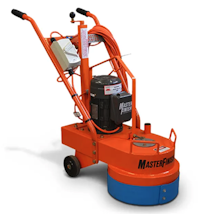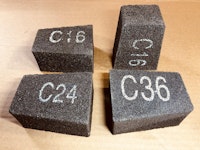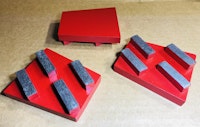Grinding Shoes
I carry a range a small range of basic diamond grinding shoes to suit cub grinders in Bibra Lake .
My high quality metal Redilock shoes are compatible with other grinding machines from different manufacturers. These are popular with floor layers, DIY etc
Suitable for wet and dry grinding.
It is impossible to make a recommendation on YOUR grinding job. Every job is different.
For tips on grinding, see information at the bottom of this page.
Redilock Shoes:
Redi Lock Single Segments – ideal for general grinding with lighter, single phase machines.
#25 grit is ideal for first pass, then #80 for second pass.
Tyrolit H2 Gold #25 single segment - W shaped. Soft/medium bond for hard concrete
Tyrolit Redilock H4 Brown #80 single segment - W shaped. Soft/medium bond for hard concrete
Tyrolit Redilock X2 Gold #25 single segment - W/M shaped. Special soft bond for extremely hard concrete
Tyrolit Redilock X4 Brown #80 single segment - W/M shaped. Special soft bond for extremely hard concrete
All $25 each incl GST
Redi-Loc Double Segments – ideal for general grinding with heavier, often three phase machines.
Tyrolit H2 Gold #25 double segment - W shaped. Soft/medium bond for hard concrete
Tyrolit Redilock H4 Brown #80 double segment - W shaped. Soft/medium bond for hard concrete
Tyrolit Redilock X2 Gold #25 double segment - W/M shaped. Special soft bond for extremely hard concrete
Tyrolit Redilock X42 Brown #80 double segment - W/M shaped. Special soft bond for extremely hard concrete
All $35 each incl GST
Tyrolit Redilock S3 DS Rectangle Red #40.
Two segments.
Very hard bond for soft/green concrete.
Ideal for grinding green concrete with 250mm machine.
(Try 3 shoes initially. If they wear too fast, try 6 shoes.)
$45 each incl GST
Coffin shaped for general grinding.
Two segments.
Squarer segments have a long leading edge, so are ideal on uneven concrete.
For hard to medium concrete
Premium quality (all Korean)
Rediloc Shoes #25 /30 grit
Rediloc Shoes #50 /60 grit
Rediloc Shoes #100 grit
All $55 each incl GST each
(or $450 incl GST per box of 9 shoes)
Arrow shoes are for glue removal and quick removal of thick layers of epoxy and paint.
Used for general grinding as well.
12mm height, #25 grit, two segments, medium bond.
All $50 each incl GST each
(or $45 each incl GST in box of 9 shoes)
PCD Shoe: 2 x PCD per segment, for very aggressive removal of glue, epoxy etc
$100 each incl GST
Available in clockwise and anti clock wise station (check which you need).
(Poly Crystalline Diamond feature chunky diamond particles for fast removal of thick and sticky compounds like paint, epoxy, mastic, adhesives, urethane and residues. They are commonly used when conventional diamond shoes will not grind the material quick enough or they tend to get clogged up. This is ideal if you are applying another compound.
But if you want a smoother surface, they will be too rough.
Plate:
250mm Cub grinder plate with nine Redilock shoe slots.
$250 each incl GST
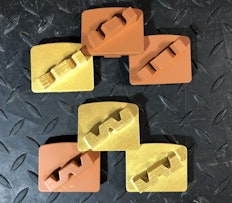


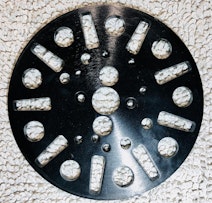
|
Masterfinish G1-A Grinder consumables |
|
|
Wedge - abrasive segment |
|
|
Wedge diamond block - medium grit |
|
.
.
.
Lavina Quick Change Grinding Shoes - CLEARANCE:
Cub Grinder Plate:
250mm Cub grinder plate with six Lavina quick change shoe slots
$195 each incl GST
Quick Change Shoes:
One segment $25 each incl GST
Two segments $35 each incl GST (available medium and hard, #25/30, #50 and #140)
Super hard bond is for very soft concrete. Maybe it's due to the sand type in the Perth region but whatever it is, I find this bond works well and lasts decently. My normal hard bond for some reason tends to wear a bit too fast on soft and relatively green concrete in Perth, despite the general rule that Perth concrete is harder than that of the east coast.
Two segments $45 each incl GST
Epoxy/glue etc removal:
Arrow Shoe:
Arrow shoes are used for general grinding as well as adhesive, epoxy and paint removal.
2 x arrows per segment, #16 soft bond for very hard concrete, for removal of glue, epoxy etc
$40 each incl GST
PCD Shoe:
Poly Crystalline Diamond feature chunky diamond particles for fast removal of thick and sticky compounds like paint, epoxy, mastic, adhesives, urethane and residues.
2 x PCD per segment, for very aggressive removal of glue, epoxy etc
$65 each incl GST
Available in clockwise and anti clock wise station (check which you need).
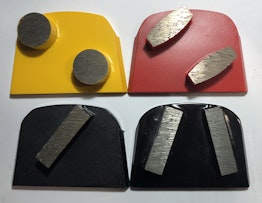
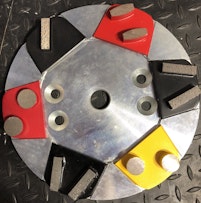
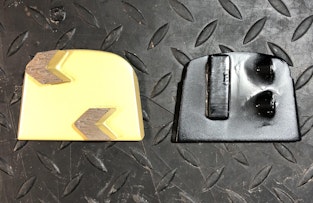
Note - When workers cut, crush, saw, drill, polish or grind products that contain silica, particles are created, which are one-hundredth of the size of a grain of sand. These can get stuck deep in the lungs. Ensure precautions to limit exposure to dust are in place.
Use a half face respirator or a PAPR (Powered air purifying respirator).
See the WA government's info on silica dust here.
Prices correct as of 1/2/25 but subject to change.
Please see our "Contact Us" page (here) for Australia wide delivery information.
Grinding with Cub Grinder:
See tips at the bottom of this page
A Guide to Concrete Grinding:
While this introduction is basic only, it does give you a few ideas and considerations when grinding concrete.
It is hard to guess the hardness of concrete. I suggest you start with a hard bond (for soft concrete). If it is not cutting, or is very slow, try a softer bond.
Concrete grinding is the process of removing high points, contaminants, and loose material from a concrete surface using a grinding machine. When grinding concrete, the bond of the diamond shoes should normally be the opposite of the concrete, ie use a soft bond on hard concrete, and a hard bond on soft concrete. Use a larger diamond grit (lower number) for faster removal of concrete and for harder concrete.
If you mis-match, the results will be poor. A hard bond with hard concrete will not grind, whereas a soft bond on soft concrete will wear out the shoes very fast.
Grinding hard concrete does not produce much dust, and it is usually soft and non abrasive. The diamonds cut, blunt and break as normal, but the metal bond surrounding them is not worn away easily without the dust, so the diamonds are not exposed as much as with soft concrete. The diamond segment glazes over and stops working and rubs on the floor instead of cutting it. You can use larger diamonds (around 25 grit) to increase dust production. Also, reduce the surface area with fewer segments to increase the weight per square centimetre.
Grinding soft concrete usually produces sufficient gritty, abrasive dust that will wear away the bond and expose the diamonds adequately. In fact, too much dust can cause the grinding wheel to wear too fast, so vacuum up excess dust. Reduce the weight on the wheel or increase the surface area with more segments to reduce the weight per square centimetre.
Inspect your grinding shoes regularly to make sure diamonds are exposed adequately and that they are not overheating . Even the best shoes will perform badly if used in the wrong application.
Grinding Exposed aggregate with Cub Grinder:
Some operators use half hard bond and half soft bond, to cope with the two different hardnesses in the floor (for the aggregate and the concrete).
Others use a hard bond with water. Try lots of segments, or double segments, to reduce bouncing.
4 steps to grinding a concrete floor
- Know the Surface – A diamond grinder is suitable for removing light, thin layers, not aggressive profiling and shaping.
- Prepare the surface – If the floor has some coatings on it (even small patches), these need to be removed before grinding. One run over is not enough, and proper surface rehabilitation must be done over several steps, each step graduating to the next to ensure a smooth finish to the floor.
- Select the correct diamond shoe – Each particular floor is going to dictate your choice of diamond shoe.
There are a number of things to consider which diamond segment is appropriate.
- The bond is the material that initially holds the diamonds in place, but also wears away to expose the diamonds. A hard bond is best when dealing with abrasive material like soft concrete or rain-damaged concrete.
Medium bond tends to perform poorly with hard materials, but wears away more quickly on abrasive materials. Soft bonds are ideal on hard materials because it wears away quickly, exposing a layer of diamond to grind the surface.
- Grit is the diamond size in the bond, and ranges from coarse to fine. Start with a coarse grit (16-30 grit) to remove the uneven areas. Double the grit size with each stage, gradually breaking down the surface irregularities until the surface is sufficiently smooth.
#16 grit is very coarse for removing coatings like glue, lacquer, paint, epoxy etc
#25 grit is for rough grinding such as levelling and floor preparation.
#40/50 grit is for medium grinding applications
#80-#100 is for fine grinding
- The shape of the diamond segments used has an impact too. Arrow heads have sharp leading edges for slicing and are effective for glue removal. Square segments have a long leading edge, so are ideal on uneven concrete. Round headed diamonds have a subtle leading edge so are perfect for working with finer grits.
Generally, segments with a sharper leading edge tends to deliver more aggression, while tapered shapes tend to deliver better dispersion.
- Shoes with one only segment are generally for lighter, smaller grinders eg Cub grinders, whereas shoes with two segments per shoe suit heavy three phase machines.
- More shoes means more segments, which is a lighter electrical load. - Use correct grinder weight – The weight on the machine can affect the wear and tear on the machine, as well as effectiveness of grinding. Heavier pressure is more aggressive on the surface, where as lighter pressure is less aggressive. On some grinders, you can add ballast weights if needed, whereas others you cannot add weight. Alternatively, use less shoes, or shoes with one segment not two to increase the pressure.
General shoe recommendation:
It is impossible to make a recommendation on YOUR grinding job. Every job is different.
But most jobs with a Cub style grinder can achieve good results with:
- Three or six single segment shoes, soft/medium bond for hard concrete. #25 grit for first pass.
(Experiment with 3 or 6 shoes for best balance of speed of cutting and shoe life) - Three or six single segment shoes, soft/medium bond for hard concrete. #80 grit for second pass.
Tips:
Dampening the concrete before grinding, or even spraying a little water may assist with your job ( be careful mixing water with electricity - use an RCD). It will make a grinding paste.
Similarly, clean builders sand on the surface, or reducing dust extraction, will help the grinding process.
A grinding compound such as Worx+ Totally Cut Sikk can assist grinding.
Do not let segments get too hot. Over heating will cause slower grinding and the segments will glaze over.
To stop them glazing, spray a little water on the concrete
If the segments glaze up, adding clean builders sand to the surface can open up the segments again.
Remember - every job is different. The enormous combinations of different types of surfaces, different cup wheel styles, with many different bonds and grits, plus different machines and varied operator experience means it is impossible to guess what will give the perfect result the first time. Some experimentation is often necessary to achieve the required results.
Videos:
For tips on grinding very hard concrete see a 15 minute Youtube video here
This is an American video, showing a whole job from start to finish with commercial sized machines. 25 minutes.
3.30 to 4.40 shows all the different grit and bond shoes a pro carries to suit all different concrete jobs.
They did 2 grinds on #40 and one at #80 to expose the aggregate, then finished at #150 to #800 resin polishing pads.
You judge the result - it would be impossible to predict it.
Disclaimer: the information on this website is provided in good faith and believed to be reliable and accurate at this time. However, the information is provided on the basis that the reader will be solely responsible for assessing the information and its veracity and usefulness.
UDT shall in no way be liable, in negligence or howsoever, for any loss sustained or incurred by anyone relying on the information, even if such information is or turns out to be wrong, incomplete, out-of-date or misleading.

